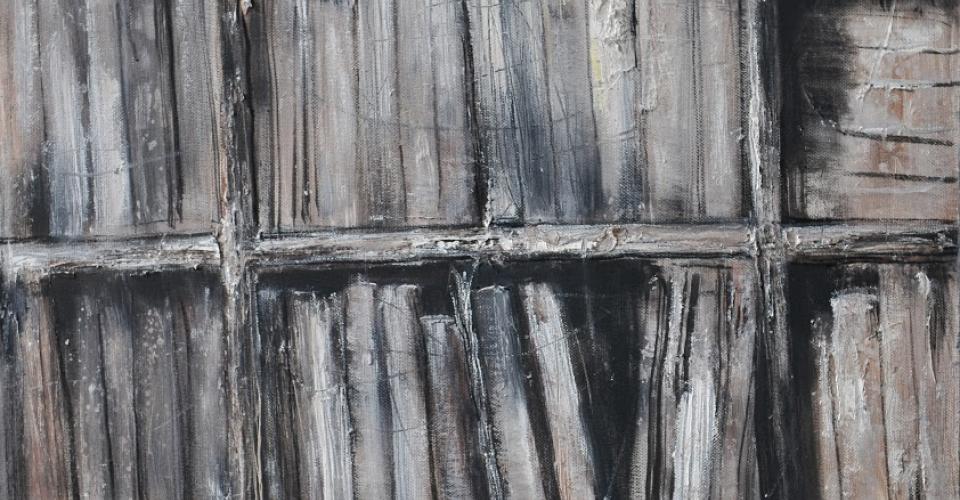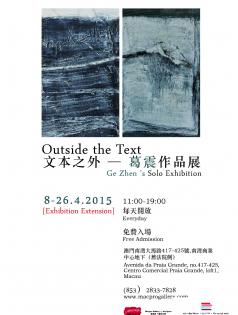Everyday
11:00H-19:00H
In Outside the Text, we present 20 selected artworks of Ge Zhen, illustrating the artist’s creation from 2010 to 2014. Ge Zhen has brought some of his latest work to Macau for this exhibition including paintings from the series The Backyard and Outside the Text. “The Backyard” can be viewed as an extension of Ge Zhen’s previous work, and it seems the theme of “limitation and liberation” has now become an inevitability on his canvas, one that cannot be wiped away. Those potted plants seem to be ravishingly in bloom under the sun, but deep inside they share the same fate as the birds trapped in their cages. Outside the Text, on the other hand, is a distillation of the artist’s thoughts: text with immortality or with death, text with opium poppy or with poison, text with text or the intertextuality between them, and so on. All these are questions posed to the viewers.
Organisers
Macpro Gallery
The Script Road
Venue
Avenida da Praia Grande, No. 417-425,
Centro Comercial Praia Grande, loft 1
Macau
T: 2833 7828
E: info@macprogallery.com
Gauge the Sky with the Wings of Freedom
Before organising this exhibition, Ge Zhen and I were not acquainted, and still to this day we have not yet met. When I was preparing for the publication of my poetry collection Distant Songs in 2008, I saw Ge Zhen’s paintings by chance in Nanjing Reviews, of which Huang Fan was Editor-in-Chief. It was love at first sight, and, after gaining his approval through some mutual friends, I selected a number of his works to serve as the illustrations for my poetry collection. To feature on the cover I chose an image of a bird that had sacrificed itself, crushing its head against its cage, leaving only a sparse skeleton and eyes staring at the Birds, cages and winged man are the key symbols in Ge Zhen’s work.
The birds in his work are not those that soar and hover in the sky, but rather the ones imprisoned, with drooping wings and skeletal frame. Perhaps they once did gauge the sky with their wings of freedom. Nevertheless, captivity is their denouement. Unwilling to forfeit the right to stretch their wings, they will perish in the cage at the end of the day. In point of fact they could have an easy, comfortable life in the cage. They need not search for food, so a cage might feed a large number of birds, even a human. However, there are always birds and people who refuse to trade their liberty for the feed that is doled out in contempt. These are the birds – or, we ought to say, the people or the spirit – in Ge Zhen’s work. So, the birds and cages are the symbolic elements in his paintings. They have been used repeatedly to express the theme of limitation of a former liberty. Or perhaps this grand proposition was not intentional but rather the reflection of an artist’s difficult life en route to the core of his artistic
In the series The Birds, Ge Zhen tends to use cold, greyish colour and simple brushwork. He also intentionally leaves a mark in the oil painting that gives a taste of the desolate: a desolate background, a rotten birdcage, withered branches.... Despite the fact that he has used the brushwork of oil painting, there is always hint of oriental scenery reminiscent of Ni Zan’s landscape painting or the monochrome, withered branches in Bada Shanren. There is no doubt this is a reflection of pessimism. Nevertheless, there is a co-existence between miserable desolation and profound sacrifice. Look at the birds, even if all they have is their own gaunt skeleton, they still stand tall, with dignity, and retain the soaring Another key symbol is the winged man, not the angel of religious legends, but the human who strapped a pair of wings on, himself. The human story of learning to soar with the birds is a long one, but we did not grow wings through all that soaring until the airplane was invented. If the winged man did not have that fantasy and the bloody, deadly experience, there would be no airplane today. From this point of view these winged men share traits and a spirit in common with the birds. They both desire to free themselves from the frame and yearn for a wider space. However, not one of the winged men in his works is portrayed in flight. They all just carry the wings, earthbound, walking, sitting, lying or even swinging. Some of them even wear masks, whether for oxygen at high altitudes or to protect from the poison of smog.
Ge Zhen has brought some of his latest work to Macau for this exhibition including paintings from the series The Backyard and Outside the Text. “The Backyard” can be viewed as an extension of Ge Zhen’s previous work, and it seems the theme of “limitation and liberation” has now become an inevitability on his canvas, one that cannot be wiped away. Those potted plants seem to be ravishingly in bloom under the sun, but deep inside they share the same fate as the birds trapped in their cages. Outside the Text, on the other hand, is a distillation of the artist’s thoughts: text with immortality or with death, text with opium poppy or with poison, text with text or the intertextuality between them, and so on. All these are questions posed to the viewers.
Art, having undergone so many years of development, no longer simply exists for aesthetic purposes and to be admired. Rather, it is closely connected to the development of society. Art is a way to express liberty and individuality, but at the same time it can be used to doubt and judge, applying introspection and scepticism to the shackling of survival to reality. All in all, to be a great artist one not only needs to possess an individual style and wonderful painting skills, but also the ability to question reality and imagine the future. Ge Zhen is on his way, and his destination is neither a birdcage nor a backyard, but a spacious plateau and the vast blue sky.
Curator: Yao Feng
Macau, March 2015

